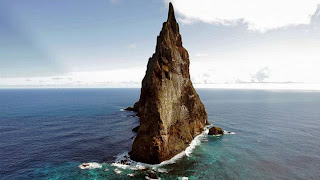The Door to Hell is a natural gas field in Derweze which is also called Darwaza, actual meaning is"gate", Ahal Province, Turkmenistan. The Door to Hell is noted for its natural gas firing which has been burning incessantly since 1971 as it was lit by Soviet petrochemical scientists, fed by the rich natural gas deposits in the area. The pungent smell of burning sulfur permeates the area for some distance. The field is located near the Derweze village in the middle of the Karakum Desert, about 260 kilometers north from Ashgabat. The gas reserve found here is one of the largest in the world. The name, "Door to Hell", was given to the field by the locals, referring to the fire, boiling mud and orange flames in Derweze's large crater with a diameter of 230 ft. Source: Charismatic Planet
A compendium of interesting places, hidden wonders, Beautiful Places, strange travel destination, tourist attractions.
Monday, 20 May 2013
Ball's Pyramid Australia
Ball's Pyramid is an erosion remnant of a shield volcano and caldera that formed about seven million years ago. Ball's Pyramid is approximately 20 kilometers. It is 1,844 ft high, while measuring only 3,600 ft in length and 980 ft across, making it the tallest volcanic stack in the world.
The Balls Pyramid was named after Lieutenant Henry Lidgbird Ball, who discovered it in 1788. He was first person to go ashore is believed to have been Henry Wilkinson in 1882, who was a geologist at the New South Wales Department of Mines. The first winning climb to the summit was made on 14 Feb 1965 by a team of climbers from the Sydney Rock Climbing Club, consisting of Bryden Allen, John Davis, Jack Pettigrew and David Witham.
The Balls Pyramid was named after Lieutenant Henry Lidgbird Ball, who discovered it in 1788. He was first person to go ashore is believed to have been Henry Wilkinson in 1882, who was a geologist at the New South Wales Department of Mines. The first winning climb to the summit was made on 14 Feb 1965 by a team of climbers from the Sydney Rock Climbing Club, consisting of Bryden Allen, John Davis, Jack Pettigrew and David Witham.
Hiran Minar Sheikhupura Pakistan
Some
43 kilometers northwest from Lahore and 9 kilometers from Sheikhupura is
located the well-known 100 foot high Hiran Minar, above left, built by the
Emperor Jahangir in the 17th Century for a beloved antelope, by mistake killed
by Jahangir during hunting with friends. Sheikhupura then had the status of a
royal hunting ground. Hunting grounds were essential part of the physical
environment of Mughal emperors. The place where the town stands today was one
of Jahangir’s (Prince Saleem) princely dominions during his father Akbar’s
reign. The town was founded by Jahangir, near village Sahu Malli, during his
rule in 1607. The king declared the barren jungles adjoining the place as royal
hunting ground. After the death of king’s darling deer Mans Raj, this hunting
ground was changed into a protected sanctuary and hunting was prohibited. In
the memory of his favorite antelope, the king has also constructed an octagonal
tower in 1607 at the foot of the grave of the deer and in 1620 a square
beautiful lake like pond and Baradari were added to the monument. After the
death of king’s dearest deer Mans Raj, this hunting ground was changed into a
protected sanctuary and hunting was prohibited.
A
unique feature of this beautiful Hiran Minar is its location and environment:
the top of the Minar is maybe the best place in the province of Punjab to get a
sense for the broader landscape and its relationship to a Mughal site. The
bereaved emperor ordered a minaret to be built at his grave; therefore the name
is called Hiran Minar. The Hiran Minar originally measured 110 feet in height,
but after sometime, its canopy collapsed, leaving it in its present headless
state. The Hiran Minar has 108 steps on a spiral staircase lead to its summit, where
rest the remains of Mansraj. The cost incurred on the construction of the
minaret was Rs150, 000, which was considering hefty amount in those times.
Subscribe to:
Posts (Atom)






















































